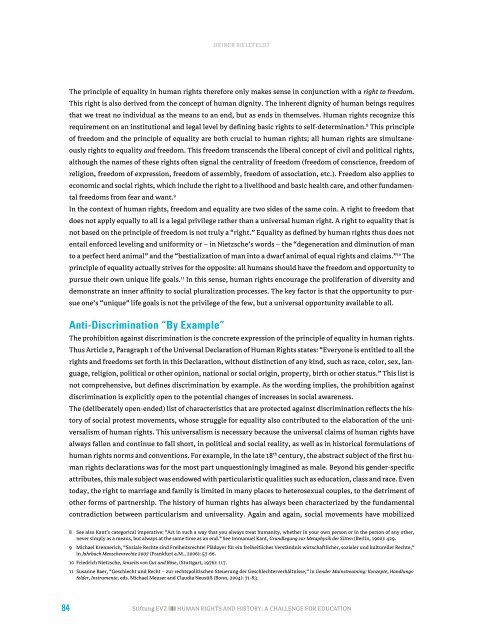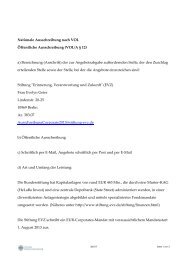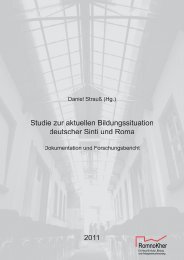chapter 2 - Stiftung "Erinnerung, Verantwortung und Zukunft"
chapter 2 - Stiftung "Erinnerung, Verantwortung und Zukunft"
chapter 2 - Stiftung "Erinnerung, Verantwortung und Zukunft"
Create successful ePaper yourself
Turn your PDF publications into a flip-book with our unique Google optimized e-Paper software.
Heiner Bielefeldt<br />
The principle of equality in human rights therefore only makes sense in conjunction with a right to freedom.<br />
This right is also derived from the concept of human dignity. The inherent dignity of human beings requires<br />
that we treat no individual as the means to an end, but as ends in themselves. Human rights recognize this<br />
requirement on an institutional and legal level by defining basic rights to self-determination. 8 This principle<br />
of freedom and the principle of equality are both crucial to human rights; all human rights are simultaneously<br />
rights to equality and freedom. This freedom transcends the liberal concept of civil and political rights,<br />
although the names of these rights often signal the centrality of freedom (freedom of conscience, freedom of<br />
religion, freedom of expression, freedom of assembly, freedom of association, etc.). Freedom also applies to<br />
economic and social rights, which include the right to a livelihood and basic health care, and other f<strong>und</strong>amental<br />
freedoms from fear and want. 9<br />
In the context of human rights, freedom and equality are two sides of the same coin. A right to freedom that<br />
does not apply equally to all is a legal privilege rather than a universal human right. A right to equality that is<br />
not based on the principle of freedom is not truly a “right.” Equality as defined by human rights thus does not<br />
entail enforced leveling and uniformity or – in Nietzsche’s words – the “degeneration and diminution of man<br />
to a perfect herd animal” and the “bestialization of man into a dwarf animal of equal rights and claims.” 10 The<br />
principle of equality actually strives for the opposite: all humans should have the freedom and opportunity to<br />
pursue their own unique life goals. 11 In this sense, human rights encourage the proliferation of diversity and<br />
demonstrate an inner affinity to social pluralization processes. The key factor is that the opportunity to pursue<br />
one’s “unique” life goals is not the privilege of the few, but a universal opportunity available to all.<br />
Anti-Discrimination “By Example”<br />
The prohibition against discrimination is the concrete expression of the principle of equality in human rights.<br />
Thus Article 2, Paragraph 1 of the Universal Declaration of Human Rights states: “Everyone is entitled to all the<br />
rights and freedoms set forth in this Declaration, without distinction of any kind, such as race, color, sex, language,<br />
religion, political or other opinion, national or social origin, property, birth or other status.” This list is<br />
not comprehensive, but defines discrimination by example. As the wording implies, the prohibition against<br />
discrimination is explicitly open to the potential changes of increases in social awareness.<br />
The (deliberately open-ended) list of characteristics that are protected against discrimination reflects the history<br />
of social protest movements, whose struggle for equality also contributed to the elaboration of the universalism<br />
of human rights. This universalism is necessary because the universal claims of human rights have<br />
always fallen and continue to fall short, in political and social reality, as well as in historical formulations of<br />
human rights norms and conventions. For example, in the late 18 th century, the abstract subject of the first human<br />
rights declarations was for the most part unquestioningly imagined as male. Beyond his gender-specific<br />
attributes, this male subject was endowed with particularistic qualities such as education, class and race. Even<br />
today, the right to marriage and family is limited in many places to heterosexual couples, to the detriment of<br />
other forms of partnership. The history of human rights has always been characterized by the f<strong>und</strong>amental<br />
contradiction between particularism and universality. Again and again, social movements have mobilized<br />
8 See also Kant’s categorical imperative: “Act in such a way that you always treat humanity, whether in your own person or in the person of any other,<br />
never simply as a means, but always at the same time as an end.” See Immanuel Kant, Gr<strong>und</strong>legung zur Metaphysik der Sitten (Berlin, 1900): 429.<br />
9 Michael Krennerich, “Soziale Rechte sind Freiheitsrechte! Plädoyer für ein freiheitliches Verständnis wirtschaftlicher, sozialer <strong>und</strong> kultureller Rechte,”<br />
in Jahrbuch Menschenrechte 2007 (Frankfurt a.M., 2006): 57-66.<br />
10 Friedrich Nietzsche, Jenseits von Gut <strong>und</strong> Böse, (Stuttgart, 1976): 117.<br />
11 Susanne Baer, “Geschlecht <strong>und</strong> Recht – zur rechtspolitischen Steuerung der Geschlechterverhältnisse,” in Gender Mainstreaming: Konzepte, Handlungsfelder,<br />
Instrumente, eds. Michael Meuser and Claudia Neusüß (Bonn, 2004): 71-83.<br />
84<br />
<strong>Stiftung</strong> EVZ<br />
HUMAN RIGHTS AND HISTORY: A CHALLENGE FOR EDUCATION

















